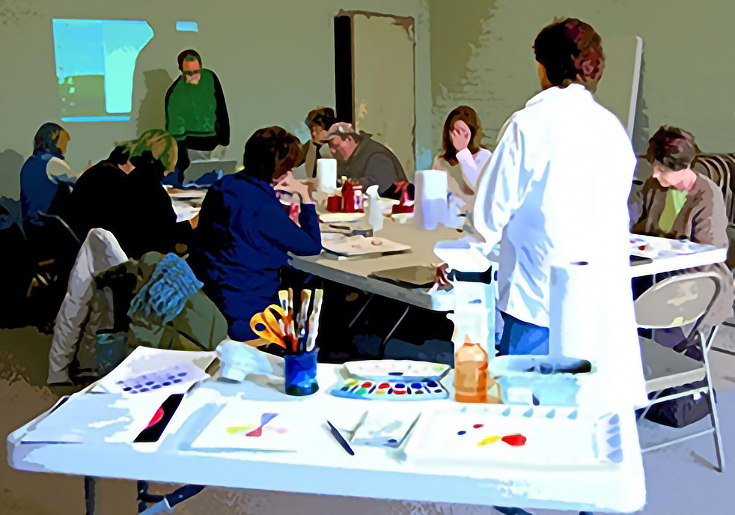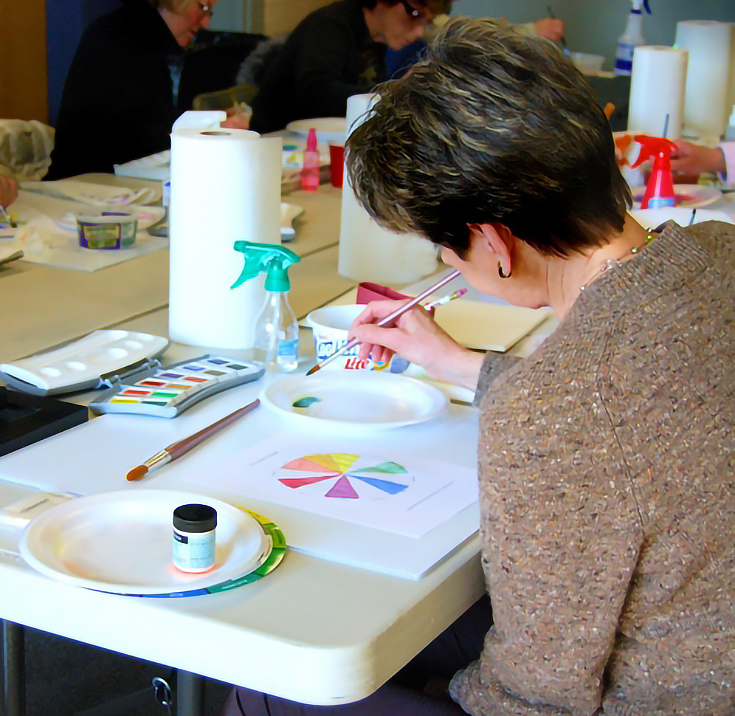As an instructor I am often asked what a student can do to get the most out of their workshop experience. After all, your art class experience depends a great deal on you.
What are your expectations? How will you respond to your instructor and other students? Will you fully invest yourself in the experience?
My hope is that you will find this article helpful in preparing for future classes.
Be prepared, every day!
Your instructor carefully creates a list of supplies for the class. Unless an item is listed as optional, bring every item to every class.
Before your first class, create a “workshop kit.” This kit will include everything on the supply list as well as any additional supplies you wish to include, all organized in a tote or crate. Stash the supply list in your kit. Prior to each class, use this list as a checklist to verify that all essential supplies will be available to you during class.
Do not leave items like your dryer at home. Just because everyone is supposed to bring one does not mean it’s okay to “forget” yours. If you use up any of your supplies during the week, make sure to replace them before the next class.
Have good classroom etiquette
You may be enthusiastic about greeting fellow students, or excited to share your latest artwork, but take care of the business at hand when you get to class. Arrive on time and immediately engage in the process of setting up your work area.
There will be time to chat and share your latest work, but class time is precious. Help everyone make the most of it by sharing at the appropriate time.
If you do arrive a bit late and a demonstration is already in progress, just find your seat and focus on the demo. Afterward you can go about the business of preparing your work area for class.
Be respectful of your instructor and fellow students. Keep your “stuff” within your allotted workspace. Place coats and bags, etc. in the specified area. If you carry your supplies in a large or bulky carrier, once you have set up your workspace, place it out of the way of yourself and others.
It may appear that there is space on the table next to you but you have no way of knowing whether another student may arrive after you or the instructor may need that surface area during class. Additionally, a tidy work area is conducive to greater creativity and productivity.
Learn to work with your instructor
Evaluate your instructor’s teaching style early on. It will quickly become apparent whether he or she encourages free-flowing exchanges during the class, or prefers a question/answer style of instruction.
This assessment and your response to this information will help you understand how to interact during class time and assist the teacher in giving you the best learning experience possible. Understand that your instructor has a plan for the class. Consequently, it is essential that he or she be allowed to get through all of the points of that particular lesson plan.
Each instructor has certain goals for the class. The primary goal is, of course to educate. Secondary to that is creating an energized, friendly environment where the student feels welcomed and comfortable. This fosters another goal which is to create excitement within the student to propel them onward, beyond the classroom, in their personal art journey. We want to make a difference for every student.
Some art instructors can teach in chaos, but like so many creative spirits, I personally do not do well in such an environment. Those of us who are easily distracted require a less chaotic atmosphere in order to effectively share our knowledge.
We all want our students to complete the workshop with increased knowledge, experience, and confidence related to the subject matter. So when your instructor is speaking, give them your full attention. What they are saying is most likely going to make a difference in your artistic growth. Make the most of your time with them by respectfully listening to them.
When you do have the opportunity to share or ask questions, do so without hesitation. Your questions are probably the same as others may have. Your comments and feedback are critical as they may trigger an informative discussion that adds significantly to the teacher’s offerings.
Follow up on what you learn
Don’t toss that workshop hand-out in your bag and forget it. Most likely it contains information to reinforce and support the points and techniques offered in class.
I often supply online tutorial links in my handouts that contain additional information of value to that particular workshop. If a student chooses not to take advantage of the information offered, they are most likely missing an important component of the learning experience.
If your instructor expects students to do work at home, it is generally included in the course description. When students sign up for the class, they are “signing on” to fulfilling this responsibility.
Sure, most instructors will not chastise you for not doing your “homework” like you are a junior high school student. But isn’t that really the point? You aren’t in junior high any more. Expect to spend some time between classes practicing and honing the skills and techniques featured in class.
Remember, no pain, no gain!
Don’t hesitate to paint during class time because you aren’t as good as your neighbor! It may be intimidating to reveal your skill level by trying things in class but those who fully engage in all class activities learn more quickly than those who are too shy to try.
Expect your artwork to be disappointing as you are developing your skills in class. For every poor result, a learning experience has taken place. Look at those pieces not as failures but as stepping stones on your path to becoming the artist you want to be!
If you are stuck or frustrated, share this with your instructor in a way that does not adversely influence the optimistic classroom atmosphere. One verbose student can destroy the creative joy of the entire class by complaining and grousing about their progress. Laugh at your mistakes, understanding that it takes a lot of dreadful artwork to begin producing really good art!
When your class is completed, do not hesitate to let your instructor know how you felt about the class. A happy student is the maximum reward for a dedicated teacher but if you have suggestions for improvement, share that as well. Most instructors count on objective feedback to improve the classroom experience for future students.
Next time you have the opportunity to take an art class, I hope you will take advantage of these suggestions for a more enjoyable, productive learning experience.
This post may contain affiliate links.


